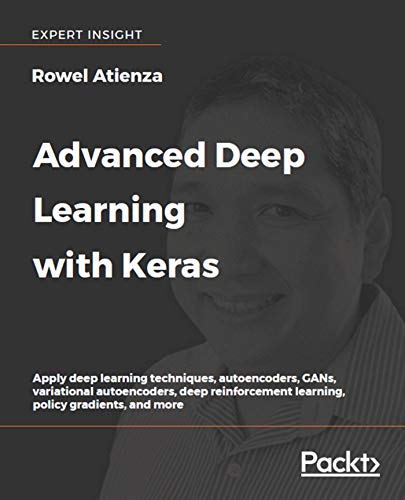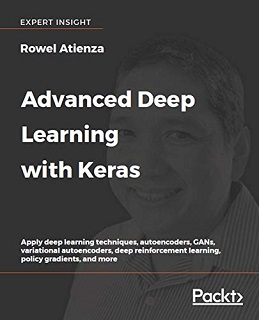
Product details
- Publisher : Packt Publishing; 1st edition (October 31, 2018)
- Publication date : October 31, 2018
- Language : English
- File size : 40970 KB
- Print length : 368 pages
- by Rowel Atienza (Author)
- Format : epub、pdf、azw3
Publisher’s Note: This edition from 2018 is outdated and is not compatible with TensorFlow 2 or any of the most recent updates to Python libraries. A new second edition, updated for 2020 and featuring TensorFlow 2 and coverage of unsupervised learning using mutual information, object detection, and semantic segmentation, has now been published.
A comprehensive guide to advanced deep learning techniques, including autoencoders, GANs, VAEs, and deep reinforcement learning that drive today’s most impressive AI results.
Key Features
- Explore the most advanced deep learning techniques that drive modern AI results
- Implement deep neural networks, autoencoders, GANs, VAEs, and deep reinforcement learning
- A wide study of GANs, including Improved GANs, Cross-Domain GANs, and Disentangled Representation GANs
Book Description
Recent developments in deep learning, including Generative Adversarial Networks (GANs), Variational Autoencoders (VAEs), and Deep Reinforcement Learning (DRL) are creating impressive AI results in our news headlines – such as AlphaGo Zero beating world chess champions, and generative AI that can create art paintings that sell for over $400k because they are so human-like.
Advanced Deep Learning with Keras is a comprehensive guide to the advanced deep learning techniques available today, so you can create your own cutting-edge AI. Using Keras as an open-source deep learning library, you’ll find hands-on projects throughout that show you how to create more effective AI with the latest techniques.
The journey begins with an overview of MLPs, CNNs, and RNNs, which are the building blocks for the more advanced techniques in the book. You’ll learn how to implement deep learning models with Keras and TensorFlow 1.x, and move forwards to advanced techniques, as you explore deep neural network architectures, including ResNet and DenseNet, and how to create autoencoders. You then learn all about GANs, and how they can open new levels of AI performance. Next, you’ll get up to speed with how VAEs are implemented, and you’ll see how GANs and VAEs have the generative power to synthesize data that can be extremely convincing to humans – a major stride forward for modern AI. To complete this set of advanced techniques, you’ll learn how to implement DRL such as Deep Q-Learning and Policy Gradient Methods, which are critical to many modern results in AI.
What you will learn
- Cutting-edge techniques in human-like AI performance
- Implement advanced deep learning models using Keras
- The building blocks for advanced techniques – MLPs, CNNs, and RNNs
- Deep neural networks – ResNet and DenseNet
- Autoencoders and Variational Autoencoders (VAEs)
- Generative Adversarial Networks (GANs) and creative AI techniques
- Disentangled Representation GANs, and Cross-Domain GANs
- Deep reinforcement learning methods and implementation
- Produce industry-standard applications using OpenAI Gym
- Deep Q-Learning and Policy Gradient Methods
Who this book is for
Some fluency with Python is assumed. As an advanced book, you’ll be familiar with some machine learning approaches, and some practical experience with DL will be helpful. Knowledge of Keras or TensorFlow 1.x is not required but would be helpful.
About the Author
Rowel Atienza is an Associate Professor at the Electrical and Electronics Engineering Institute of the University of the Philippines, Diliman. He holds the Dado and Maria Banatao Institute Professorial Chair in Artificial Intelligence. Rowel has been fascinated with intelligent robots since he graduated from the University of the Philippines. He received his MEng from the National University of Singapore for his work on an AI-enhanced four-legged robot. He finished his Ph.D. at The Australian National University for his contribution on the field of active gaze tracking for human-robot interaction. Rowel’s current research work focuses on AI and computer vision. He dreams on building useful machines that can perceive, understand, and reason. To help make his dreams become real, Rowel has been supported by grants from the Department of Science and Technology (DOST), Samsung Research Philippines, and Commission on Higher Education-Philippine California Advanced Research Institutes (CHED-PCARI).



